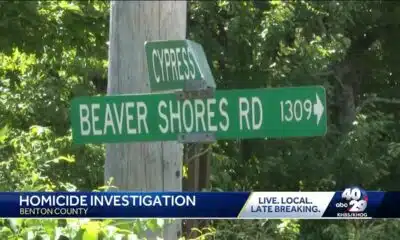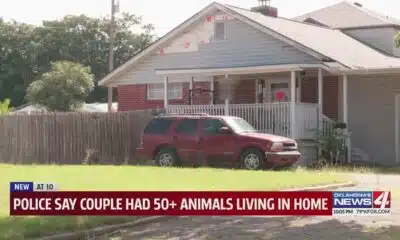News from the South - North Carolina News Feed
Yes, it always seems we have room for one more development, regardless of traffic • Asheville Watchdog
If you’ve never driven Springside Road in South Asheville, it’s a bit of an adventure.

The two-lane road, a popular cut-through between Overlook and Hendersonville roads, is hilly in places, and a little curvy. You don’t want to stop in the road in one of those blind dips, and trying to exit one of the side streets that lead to it can be downright nerve-wracking.
Now a developer wants to put 37 homes on two lots at 93 and 95 Springside, totaling 5.82 acres. Ultimately, it will need a City Council-approved rezoning that allows more density than the current zoning designation.
Not surprisingly, neighbors are not happy about this. About 40 residents filed written comments with the city’s planning and zoning board before its April 2 meeting, and a bunch turned out to speak about it in person.
Now, I know the first thought for some of you is going to be: “Well, there go the NIMBYs again, not wanting anything built in their backyards.”
I get that. We are a city that badly needs more housing, and infill projects where it makes sense.
But what’s interesting to me on this one is this fact: South Asheville has really taken the development bullet for pretty much the whole city over the past decade or so.

Thousands of apartments have gone up in Asheville during that time, as I’ve noted before, and South Asheville, Arden and Skyland have borne the brunt of that development. If you’ve ever had the joy of driving Hendersonville or Sweeten Creek roads at rush hour (which now seems to run from about 7 a.m.-10 a.m. and 3:30 p.m.-6:30 p.m.), you know what I mean.
It’s a crowded mess.
At that April 2 meeting, John Maddux, whose backyard abuts Springside, put it nicely. Maddux is a deputy city attorney for Asheville, but he made it clear he was speaking as a resident, not in his official capacity.
“South Asheville has already absorbed multiple large-scale developments very close to the site,” Maddux said. “Hundreds of units are going up on Long Shoals Road. Drive down Sweeten Creek Road. Hundreds of units are going in down there.”
Maddux noted that all of this is since the data went into the city’s “Missing Middle” housing study that suggested Asheville needs much more housing, particularly dense types that include apartments, duplexes, townhomes and more.
His point was that “South Asheville is doing its part.
“The plans that we have put to the city all say that density should be distributed equitably around the city,” Maddux said. “It would be inequitable to keep pushing density into South Asheville. I know this is 37 houses, but this is 37 houses in an area that’s not supposed to take 37 houses.”
To me, that’s the gist here. It’s an already crowded area with a large population, not to mention four schools within a few miles and busy commercial strips nearby.
Residents’ emails repeatedly brought up safety concerns about the lack of sidewalks along Springside and how dangerous that road can already be. Quite a few also said they’re not opposed to development on the vacant, wooded site, but they just want it scaled back.
“I am not opposed to this land being developed, as I understand that Asheville is growing and housing is needed,” Barbara Reeves wrote. “But developing this land needs to be done reasonably, thoughtfully, and responsibly.”
She said she’s spoken with many community members who just want a chance “to work together with the city and with a developer,” so they can “propose a solution that is in keeping with the surrounding neighborhoods.”
That April 2 meeting lasted more than three hours, and when the planning and zoning board asked the developer to consider changes to the project, its lawyer asked for the meeting to be continued. The board voted to table the matter until the May 7 meeting.
Here’s an interesting point, though, as pointed out by one of the board members: By right and current zoning, the developer can build 31 units on the site “and doesn’t have to ask anyone’s approval.”
‘The balancing act’ and steadily increasing traffic
Planning and zoning board member Jason Seickel was pretty blunt in one other assessment. Regarding traffic, he said he and other board members have been going down to Springside to drive it, especially in the mornings when school traffic is hitting.
“And yes, I agree that it’s bad, but I mean, unfortunately, a lot of Asheville is bad,” Seickel said, noting that he lives in that part of town and lives the traffic every day. But he also mentioned the housing shortage.
“This commission, we have to balance the needs of individual communities with needs of the larger community as well, too,” Seikel said. “There is a housing shortage. There is a cost-of-living crisis that outside of this room, (the board) also has to deal with, too. So, I hope you understand this — the balancing act.”
Typically that balancing act favors development, partly because of the aforementioned ability to build “by right.” Some of this goes back to old English Common Law and property rights, which run strong in our country — you have a lot when it comes to your property.
Traffic in this area, like much of Buncombe, has only increased in recent years. The NCDOT traffic count map doesn’t provide a vehicles-per-day count for Springside Road, but Hendersonville Road just south of Springside carried 30,500 vehicles a day in 2022. That’s up from 23,000 a day in 2010.
Long Shoals Road, now another major corridor down south, carried 28,500 vehicles a day in 2022, up from 18,000 a day in 2010.
Sure, adding 37 vehicles, or maybe twice that if each household has two cars, isn’t going to break the camel’s back. But it adds to the cumulative effect down south that has been building for more than a decade and has made life unpleasant, if not dangerous at times.
Honestly, if I’m in downtown Asheville after 4 p.m., I just opt to go home to Fletcher via Charlotte Highway and Cane Creek Road, which is five miles longer but 20 minutes faster. That’s mainly because I-26 remains a nightmare until you get to the newly opened lanes in Henderson County, and the other two north-south corridors, Hendersonville and Sweeten Creek roads, are parking lots.

The development does check a lot of the city’s goals
To be fair, it’s not like this proposal is some kind of monstrosity that would make people faint from shock. It is denser than the current zoning allows – it would come out to 6.4 units per acre – but it checks some of the boxes the city wants these days for infill housing.
The developer is listed as Sage Communities LLC of Hendersonville. I reached out for comment but didn’t hear back by deadline.
For the meeting, city planning staff provided a “proposed ordinance change” that states the proposal is consistent with the city’s plan called “Living Asheville — A Comprehensive Plan for our Future.” Staff determined the proposal “to be reasonable, and in the public interest for the following reasons:
a) Prioritizes greater densities of development overall, throughout the city as appropriate
b) Eliminates gaps in the sidewalk network
c) Maintains and enhances buffers and open space preservation along creeks, streams and rivers
The materials also note the subdivision would have three new access points off of Springside Road, and new sidewalks are proposed along the north side of Springside, as well as along both sides of a private road in the development. Additionally, a crosswalk is proposed across Springside Road, although neighbors questioned how safe this would be.

The city’s documents state the development “partially supports” several goals in the Living Asheville plan, including encouraging responsible growth “prioritizing greater densities of development overall,” as that helps achieve more walkable and efficient urban environments.
Also, while the project does propose single-family houses ”at a higher density than the current zoning would otherwise allow, it could reduce the footprint of the development by exploring different building types such as duplexes, townhomes, and small-scale multi-family in order to provide the same number of housing units while disturbing less of the overall site.”
The proposed homes are consistent “with the land use of the surrounding residential neighborhoods,” although they’re more densely packed, the report notes.
The report also says the development will, “Celebrate the unique identity of neighborhoods through creative placemaking — by supporting contextually appropriate infill development and a variety of housing types.”
OK, I coughed up a little lunch on that one. I mean, come on, packing in as many homes as possible is not all that creative.
The planning report dinged the development for not supporting Living Asheville goals including increasing affordable housing, and minimizing the environmental Impact on steep slopes and mature forests and wildlife habitats. It also would increase impervious surfaces.
Further, the report stated: “The proposed project is partially compatible with the surrounding land uses, including: Existing residential neighborhoods to the north, east, and south zoned Residential Single-Family Medium Density District.”
Clearly, neighbors beg to differ on the compatibility issue.
The upshot here is that some version of this development proposal is going to pass, and I suspect it will be one very close to what the developers are pursuing.
Sure, the developer will make some tweaks — save a little open space here, add more buffering there — but the company can build a fair number of units any way you slice it. And will.
And the traffic and safety situation down south, not to mention livability, will get just a little bit worse.
Asheville Watchdog welcomes thoughtful reader comments about this story, which has been republished on our Facebook page. Please submit your comments there.
Asheville Watchdog is a nonprofit news team producing stories that matter to Asheville and Buncombe County. John Boyle has been covering Asheville and surrounding communities since the 20th century. You can reach him at (828) 337-0941, or via email at jboyle@avlwatchdog.org. To show your support for this vital public service go to avlwatchdog.org/support-our-publication/.
Related
The post Yes, it always seems we have room for one more development, regardless of traffic • Asheville Watchdog appeared first on avlwatchdog.org
Note: The following A.I. based commentary is not part of the original article, reproduced above, but is offered in the hopes that it will promote greater media literacy and critical thinking, by making any potential bias more visible to the reader –Staff Editor.
Political Bias Rating: Centrist
This article presents a balanced perspective on the issue of housing development in Asheville, considering both the need for increased housing and the concerns of local residents about density, traffic, and safety. It highlights the challenges of urban growth without strongly favoring either the developer’s or the neighbors’ viewpoints. The tone remains factual and measured, reflecting an attempt to inform rather than advocate for a particular political agenda, which aligns with a centrist bias.
News from the South - North Carolina News Feed
What is Chronic Venous Insufficiency? Will Trump be okay?
SUMMARY: President Trump has been diagnosed with chronic venous insufficiency, a common condition in people over 70 causing leg swelling due to blood pooling in veins. The White House confirmed no deep vein thrombosis, arterial disease, or heart issues were found, with normal cardiac function and no signs of systemic illness. Despite visible ankle swelling and bruised hands, attributed to frequent handshaking and aspirin use, the president remains in excellent health and experiences no discomfort. At 79, he stays active, working continuously. The White House emphasized these symptoms are minor and consistent with his busy public engagements and cardiovascular prevention measures.
Swollen legs led to President Donald Trump being diagnosed with what’s called chronic venous insufficiency. It’s a fairly common condition among older adults but requires a thorough checkup to rule out more serious causes of swelling in the legs. Here are some things to know.
Chronic venous insufficiency, or CVI, happens when veins in the legs can’t properly carry blood back to the heart. That can lead to blood pooling in the lower legs. In addition to swelling, usually around the feet and ankles, symptoms can include legs that are achy, heavy feeling or tingly, and varicose veins. Severe cases could trigger leg sores known as ulcers.
WRAL App: https://www.wral.com/download-wral-apps/5787234/
The Latest Weather: https://www.wral.com/weather/page/1010362/
News Tips:
Online – https://www.wral.com/report-it/
Email – assignmentdesk@wral.com
Subscribe to WRAL:
https://youtube.com/c/wral5
Follow WRAL:
Facebook: https://facebook.com/WRALTV
X: https://twitter.com/WRAL
IG: https://instagram.com/wral
About WRAL-TV:
WRAL is your Raleigh, North Carolina news source. Check out our videos for the latest news in Raleigh, local sports, Raleigh weather, and more at https://WRAL.com
#localnews #northcarolina
News from the South - North Carolina News Feed
US House votes to yank funding for NPR, PBS, foreign aid, sending bill to Trump’s desk
SUMMARY: On July 2, 2025, the U.S. House approved legislation to cancel $9 billion in previously authorized spending on public broadcasting and foreign aid, marking only the second time in over 30 years Congress approved a presidential rescissions request. The 216-213 mostly party-line vote sends the bill to President Donald Trump for signature. The Corporation for Public Broadcasting will lose $1.1 billion in funding for NPR, PBS, and local stations. The bill also cuts $8 billion in foreign aid but protects HIV/AIDS, tuberculosis, malaria, and maternal health programs. This follows Senate approval with some adjustments and reflects the White House’s push to focus spending on American interests.
The post US House votes to yank funding for NPR, PBS, foreign aid, sending bill to Trump’s desk appeared first on ncnewsline.com
News from the South - North Carolina News Feed
Missing voter information the objection of NC search
North Carolina State Board of Elections Executive Director Sam Hayes is setting off on a mission to correct 103,000 North Carolinians’ voting records from which some information is missing.
He maintains that the process, dubbed the Registration Repair Project, will not remove any eligible voters from the state’s voter rolls.
According to the state elections board, 103,270 North Carolina registered voters have records that lack either their driver’s license number, the last four digits of their Social Security number or an indication that they have neither.
[Subscribe for FREE to Carolina Public Press’ alerts and weekend roundup newsletters]
Last year, this missing information became the stuff of headlines, lawsuits and the high-profile election protest of Republican Court of Appeals Judge Jefferson Griffin, who lost his bid for state Supreme Court to the incumbent justice, Democrat Allison Riggs, by 734 votes.
In April, the North Carolina Supreme Court declined to remove ballots from the count based on missing identification numbers; they said the state elections board, not voters, was responsible for a faulty voter registration form that didn’t make it abundantly clear that this information was required.
While Griffin lost, the issue he raised remains salient for a newly Republican elections board and the U.S. Department of Justice, which promptly sued the state board over alleged violations of the federal Help America Vote Act’s voter registration provisions.
Thursday, Hayes told reporters that a process he unveiled in late June to gather these missing identification numbers had begun in earnest.
“We must put this issue behind us so we can focus our attention squarely on preparations for accurate and secure municipal elections this fall,” he said.
The plan to collect missing information
There are two groups of voters under Hayes’ plan.
The first group includes registered voters who have never provided a driver’s license, the last four digits of their Social Security number or an affirmation that they lack both. The state elections board has asked county election boards to check their records for these numbers, in case they were provided but not correctly entered into the voting system.
In early August, the state elections board will send letters to the remaining voters in this group requesting the missing information. If affected voters do not comply, they will vote provisionally in future elections. The elections board will create a flag on these voters’ records for poll workers.
The second group includes registered voters whose records do not show that they’ve provided an identification number, but have shown additional documentation at the polls proving their identity and eligibility under HAVA. These voters may vote a regular ballot.
However, the elections board will still send them a letter in a second mailing asking for the missing identification number to bolster the state’s voter records. Even so, if they do not oblige, they still will not be at risk of being disenfranchised, NCSBE General Counsel Paul Cox said.
County election boards have already made progress, and their work will continue as the mailings go out, Hayes said.
Voters can check to see whether they’re on the list of those with missing information by using the Registration Repair Search Tool. If voters don’t want to wait for the August mailing, they can submit an updated voter registration form using their driver’s license through the online DMV portal or visit their county elections board in person with their driver’s license or Social Security card.
“We anticipate the number of voters on the list will decrease quickly as word spreads about this important effort,” Hayes said.
The State Board of Elections unanimously approved the plan last month, despite some concerns from Democrat Jeff Carmon about putting up an extra obstacle for voters because of a problem with missing information that the voters didn’t cause.
“It’s hard to understand starvation if you’ve never felt the pangs of hunger,” Carmon said. “It’s the same situation with voting obstacles. Your perspective of an obstacle may not be the same as someone who’s consistently had their identity and their validity questioned.”
Nonetheless, Carmon and fellow Democrat board member Siobhan Millen ultimately voted in support of the plan.
Same ballot, different rules
Normally, when a voter casts a provisional ballot, the county elections board determines whether their ballot counts by the post-election canvass, held nine days after an election.
Voters may have to provide documentation or information to prove their eligibility to vote in order to be accepted.
The same process applies to the 103,000 affected voters, with a catch. Their vote may be accepted for federal contests, but not state contests, due to a difference in law.

According to the DOJ’s interpretation, the National Voter Registration Act requires all provisional votes of “duly registered voters” to count, Cox said.
But the state elections board has interpreted the state Supreme Court and North Carolina Court of Appeals’ decisions in the Griffin case as requiring a driver’s license, the last four digits of a Social Security number or an affirmation that a voter has neither before accepting their votes in state and local contests.
Under a recent election law change, county election boards have three days to validate and count or reject provisional ballots.
But sometimes, mismatches happen during validation due to database trouble with reading hyphenated names or connecting maiden and married names, for example, Cox said. The board has designed a “fail safe” in case this comes up.
When there’s a mismatch during the validation process, state law allows voters to provide additional documentation — like a driver’s license, bank statement or government document with a voter’s name and address — to prove their eligibility.
“A big chunk of these voters will have already shown HAVA ID, and that’s because in the past, when this information was not supplied, the county boards would still require these voters to show that alternative form of HAVA ID when they voted for the first time,” Cox said.
Poll workers will ask provisional voters to provide this additional documentation so that they can mark it down for later, if validation doesn’t work, he added.
Democrats threaten countersuit
Last week, the Democratic National Committee threatened the state board with litigation if they went ahead with their plan regarding those with missing information.
The letter claimed that the plan would remove eligible voters from the rolls illegally.
Hayes disagrees. In his view, he’s just following the law.
“It’s not the fault of the voters,” he said. “But at the same time, we’re required by the law to go back and collect this information, which should have been done at the time, and it certainly should have been done in the intervening time.”
He also clarified that North Carolina’s photo voter ID requirement won’t suffice for the impacted voters. They still have to vote provisionally so that their identification numbers can go through the validation process, he said.
As for whether his fully fleshed out plan will appease the DNC?
“We hope so,” Hayes said.
This article first appeared on Carolina Public Press and is republished here under a Creative Commons Attribution-NoDerivatives 4.0 International License.
The post Missing voter information the objection of NC search appeared first on carolinapublicpress.org
Note: The following A.I. based commentary is not part of the original article, reproduced above, but is offered in the hopes that it will promote greater media literacy and critical thinking, by making any potential bias more visible to the reader –Staff Editor.
Political Bias Rating: Centrist
This article presents a balanced and factual report on North Carolina’s voter registration issue, focusing on the administrative process and legal context without overt editorializing. It includes perspectives from both Republican and Democratic figures, highlights legal rulings and procedural details, and covers concerns from Democrats alongside the state elections board’s explanations. The language is neutral, aiming to inform about the complexities of voter ID requirements and the Registration Repair Project without endorsing a particular political stance or framing the issue through a partisan lens.
-
News from the South - Tennessee News Feed5 days ago
Bread sold at Walmart, Kroger stores in TN, KY recalled over undeclared tree nut
-
News from the South - Arkansas News Feed7 days ago
Man shot and killed in Benton County, near Rogers
-
News from the South - Georgia News Feed1 day ago
Aiken County family fleeing to Mexico due to Trump immigration policies
-
News from the South - Alabama News Feed6 days ago
Girls Hold Lemonade Stand for St. Jude Hospital | July 12, 2025 | News 19 at 10 p.m. – Weekend
-
News from the South - Georgia News Feed7 days ago
Anti-ICE demonstrators march to Beaufort County Sheriff's Office
-
News from the South - Oklahoma News Feed7 days ago
Police say couple had 50+ animals living in home
-
Mississippi Today4 days ago
Coast judge upholds secrecy in politically charged case. Media appeals ruling.
-
Local News5 days ago
Oyster spawning begins as MDMR-USM Hatchery Program enters production phase using mobile hatchery









































